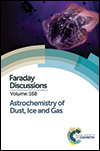Electron induced chemistry: a new frontier in astrochemistry
Abstract
The commissioning of the ALMA array and the next generation of space telescopes heralds the dawn of a new age of Astronomy, in which the role of chemistry in the interstellar medium and in star and planet formation may be quantified. A vital part of these studies will be to determine the molecular complexity in these seemingly hostile regions and explore how molecules are synthesised and survive. The current hypothesis is that many of these species are formed within the ice mantles on interstellar dust grains with irradiation by UV light or cosmic rays stimulating chemical reactions. However, such irradiation releases many secondary electrons which may themselves induce chemistry. In this article we discuss the potential role of such electron induced chemistry and demonstrate, through some simple experiments, the rich molecular synthesis that this may lead to.
- This article is part of the themed collection: Astrochemistry of Dust, Ice and Gas

 Please wait while we load your content...
Please wait while we load your content...